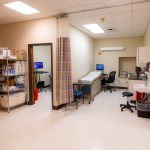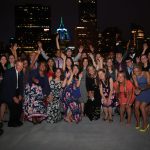 Before he was a doctor, Harry E. Lanauze, M.D., wanted to serve his country in the skies and prove that African-Americans could do anything.
Before he was a doctor, Harry E. Lanauze, M.D., wanted to serve his country in the skies and prove that African-Americans could do anything.
The young man from Washington, D.C., was so determined to serve his country that he lied about his age to enlist in the Army Air Forces when he was only 17 years old.
The passion that fueled him to blaze trails in his youth never wavered. And now, more than 70 years later, the 90-year-old Dr. Lanauze is enjoying his recent retirement from his private practice.
He spends his days with his wife, kids, grandkids, and great-grandkids. He gets to watch all of his favorite Pittsburgh sports teams. He also can reflect on a 50-year career in medicine, which included a near 40-year career at UPMC McKeesport as an emergency room physician.Before all of that, though, he was a member of the Tuskegee Airmen, a legendary group of aviation pioneers. The Tuskegee Airmen were among the first African-Americans to fly for the United States Army Air Forces. The group served during World War II as a part of the 332nd Fighter Group and 477th Bombardment Group.
But because of the racial segregation in the US Armed Forces at the time, many of these pilots faced innumerable challenges and had to fight the perception that they weren’t as good as their white counterparts.
When Dr. Lanauze first joined the military in 1943, the Tuskegee Airmen were still relatively new, having only been formed two years prior in June 1941. Their first combat mission took place in April 1943.
“He joined the military and specifically wanted to become a pilot because he was told that black men couldn’t be pilots,” said his daughter, Angela Moran, GME senior manager, UPMC McKeesport. “He said, ‘Yes, I can. I can do it.’”
 Dr. Lanauze began flight training as a flight navigator at Hondo Air Force Base in Texas before being transferred to Tuskegee University, where he received his wings as a fighter pilot.
Dr. Lanauze began flight training as a flight navigator at Hondo Air Force Base in Texas before being transferred to Tuskegee University, where he received his wings as a fighter pilot.
Soon after, he found himself flying multiple combat and bomber escort missions over North Africa, Italy, and German-held territory in mainland Europe. The aircraft he flew included the P40 War Hawk and the P51 Mustang, also known by its more famous nickname, the Red Tail.
During one trying mission, the future doctor’s plane caught on fire. Rather than abandoning the plane, Dr. Lanauze showed the calm demeanor that would later become his trademark in the ER by steadily landing the aircraft, allowing it to be salvaged.
“His thought was that it would be stupid to abandon a perfectly good plane just because it was on fire, so he landed it,” said Moran, incredulously shaking her head.
After his honorable discharge in 1946, Dr. Lanauze returned home to our nation’s capital. Eventually, he enrolled as a student at Howard University, receiving his bachelor’s degree in 1951. He then received his master’s degree from Catholic University in 1952, and became a professor of embryology and biology at Fort Valley State College in Georgia.
The years spent educating others in biology eventually fostered a new passion for Dr. Lanauze: medicine. He left his position at Fort Valley State to enroll in Meharry Medical School in Nashville, Tenn., graduating in 1961.
Though Dr. Lanauze had served his country, was well educated, and had been a college professor, he still faced the adversity of being a black man in a segregated society.
While attending medical school in Nashville, Dr. Lanauze participated in a series of sit-ins to protest the rampant racial inequality in the South.
“He would go into delis and stores and sit at the front counter and demand equal service,” Moran said. “It was just another challenge he had to overcome as a black man.”
In 1962, he moved to Liberty Borough, just outside of McKeesport, and started his rotating internship at McKeesport Hospital. Later that year, he became a full-time ER physician, a position he would keep until 1997.
But Dr. Lanauze didn’t retire from medicine altogether. He still maintained a private practice as a family doctor, and he even continued making house calls until his official retirement in 2012.
 “Many people at [UPMC] McKeesport still remember my dad,” Moran said. “If you ask them to describe him, they’ll say ‘debonair, intelligent, calm.’”
“Many people at [UPMC] McKeesport still remember my dad,” Moran said. “If you ask them to describe him, they’ll say ‘debonair, intelligent, calm.’”
Dr. Lanauze never hid his military accomplishments, even though he didn’t like talking about them. He has a shelving unit in his home office which displays miniature planes, a favorite hobby of the elder doctor. His pilot cap, goggles, and bomber jacket hang there, too.
The jacket, with the Tuskegee Airmen insignia emblazoned on the shoulder, is worn from years of age. Creases in the leather crisscross every which way, each one forming from years of flights with a young man who was making history.
These items shaped who he is but reflected a different lifetime for the doctor.
“His white doctor coats were always more prominent,” Moran said. “That’s what he was most proud of, and that’s what defines his life.”








